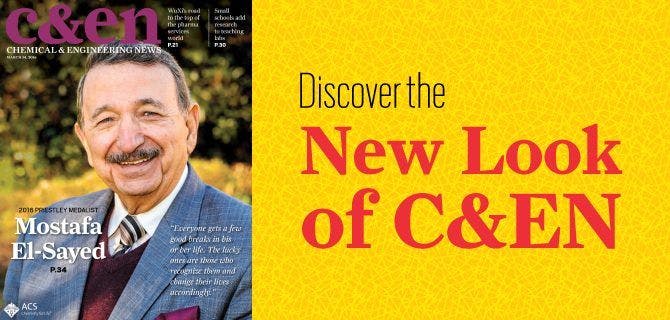Whether you’re a longtime reader or a new fan, you can’t help but notice that C&EN has a new look these days. But what prompted the redesign? And what’s next for the venerable publication? We sat down with C&EN Managing Editor Amanda Yarnell to find out. How did C&EN realize it was time for a change? […]


How did C&EN realize it was time for a change?
C&EN’s readers have long prized our coverage of cutting-edge research in chemistry and adjacent fields. But a couple of years ago we undertook a massive readership audit to determine what you valued most and why. The results were clear: Readers wanted more easy-to-digest short-form science coverage. Those preferences inspired the new magazine you see today—and are informing the new website design that we’re working on now.
What’s the underlying principle behind the redesign? Is there a “Big Idea” in mind?
Chemists tend to follow work in their own corner of chemistry closely—but C&EN delivers a bigger, broader picture. I often hear from readers that an item they serendipitously saw in C&EN catalyzed an idea for a new project or a new angle on a persistent problem. With the redesign of C&EN’s magazine, I hope many more readers will have that same experience.
To that end we put our science coverage front and center: We pulled together our short, easy-to-skim research news items and put them right in the front of the magazine. We added red keywords to the top of each story—for example, climate change, synthesis, drug discovery, or energy—to help you quickly determine whether an item is likely to interest you. And we’ve made our in-depth feature and cover stories more beautiful and more fun to read.
We’ll still catch you up with the entire world of chemistry—not just cutting-edge research news but also megamergers, hot new start-ups, chemical safety news, employment data, trends in research funding, key regulatory moves affecting our discipline, and more. We’ve just made it easier to find what you love about us.
The new design pulls shorter items to the front of the magazine. Do you think your audience is reading the magazine differently than they used to?
Readers look to C&EN’s magazine as a weekly survey of what’s new and important in the world of chemistry. That’s always been true. Now, the new Concentrates section at the front of the magazine puts that survey front and center, in a finite, easy-to-skim, finishable package.
I believe the careful curation C&EN offers is increasingly important as the universe of research papers in particular—and news in general—continues to expand. The new Concentrates section makes it easier to catch up on what you might miss in that increasing deluge. And it provides the chemistry context you won’t get anywhere else in the media.
But we’re also not afraid to dive in deep when necessary. Some of our most talked about recent stories—the implications of the Dow-DuPont merger, the toll depression takes on chemistry graduate students, an insider’s look at how to turn an academic idea into a profitable business, and the chemistry behind the water crisis in Flint, Michigan—are several pages or more. These are important pieces of journalism you won’t find elsewhere, conversations that I believe C&EN is perfectly positioned to spark. You’ll still find them in C&EN.
It looks like the new design places a much greater emphasis on art. Why is that? How has the magazine’s art evolved during your time with the publication?
As a reader, there are lots of things that will make you stop and invest in a story. An eye-catching headline. An intriguing topic. And of course, attention-grabbing graphics. For us chemists, an attention-grabbing graphic could take the form of a dramatic photo, a particularly eye-popping molecule, or a succinct diagram of the chemistry that underlies a new discovery. Chemists communicate through molecules. So I hope you’ve noticed that in the past few years we’ve been making sure that’s reflected in the pages of C&EN. Expect more of the same from the redesigned magazine.
What do you see in the future for C&EN?
I want to see C&EN become the world’s most authoritative and influential source of chemistry news. To that end, we’re busy reimagining how to best serve our readers however they’re reading our journalism, be it on their laptop, tablet, or mobile phone. We’re working to ensure that we’re valuable to and read by chemists all over the world. We’re focusing on using our journalists’ deep and broad knowledge of chemistry to surface and showcase emerging talent—as we did last year with the launch of two new annual features, C&EN’s Talented 12 and our 10 Start-ups to Watch. And whether it’s a critical look at sexual harassment in chemistry, parental leave policies in graduate school, or the public perception of chemistry—all of which you’ll see in C&EN in 2016–we continue to invest in the kinds of stories that matter, the ones that you can’t find elsewhere, the ones that you can’t help but share with your bench mate.
Thanks for reading—I hope we’ll continue to inspire you to do so for a long time to come.
